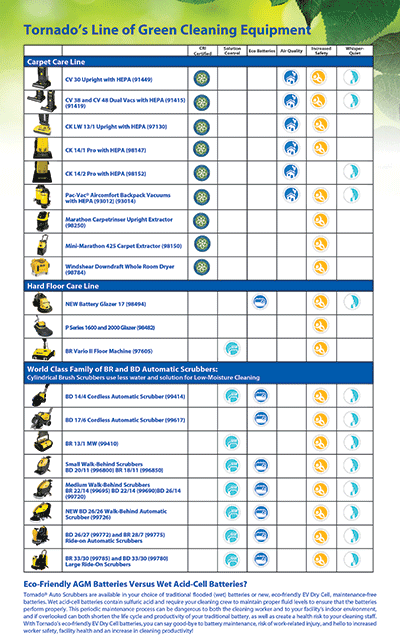Green Up Your Fleet
Spotless floors don’t come easy. In most facilities, it takes a fleet of equipment to keep everything spic and span underfoot. Choosing that machinery is always difficult, but it’s even more of a challenge when you add sustainability into the buying guidelines.
There are no green certifications specifically for floor maintenance equipment, so how does a BSC or housekeeping manager know whether a machine is environmentally friendly? We asked a sales rep at Tornado Industries with more than 30 years experience for some tips for buyers.
“First and foremost, think about the batteries,” he says. A green floor machine should have maintenance-free batteries, either gel or absorbent glass mat (AGM). Eliminating the use of battery acid is not only better for the environment but has the added benefit of reducing labor hours spent on maintaining a battery. “That, in and of itself, is a benefit.”
Eliminating Waste and Harsh Chemicals
Next, consider water usage. A green machine is one that uses as little water as possible to achieve an acceptable level of clean. For example, cylindrical provides a better cleaning result than rotating disc, and uses less water to do so. While a disc machine has 175 of rpm scrubbing power, cylindrical are 600 rpm or more; the more mechanical energy the machine generates, the less water that’s required to clean.
“That’s a big deal when water is $.16 a gallon,” says the Tornado rep. “If you have a fleet of scrubbers that clean better, faster, and with less water, that’s definitely a benefit.”
Also important in the green movement are machines that eliminate the need for cleaning chemicals. For example, orbital machines allow users to remove coats of floor finish without water or caustic chemicals.
In addition to water and chemicals, consider other forms of waste. Traditional rotating disc machines, for example, require pads that must be replaced (and thrown into landfills) frequently. Cylindrical brushes, on the other hand, can last one to several years to dramatically reduce a facility’s waste.
Buyers should also ask about noise levels on floor equipment, which can be the loudest machines used in the cleaning industry. Those that operate below 70 decibels can help a facility earn a point toward the USGBC’s LEED certification and CIMS – GB.
Additional Features of Green Equipment
Some other things to consider include always filling scrubbers with wall or rack mounted chemical dilution systems versus the old ” glug” method. In addition, vacuums with HEPA filters should always be used to help improve indoor air quality.
Finally, while there are no green certification programs for equipment, the Carpet & Rug Institute (CRI) does offer a seal of approval for vacuums and extractors. Rated like the Olympics medals (gold, silver, and bronze), it’s the only scientific program for testing and measuring the effectiveness of cleaning equipments. It’s not a green-specific program, but CRI is a trusted resource and the machines that earn top marks are not only high quality but also often meet many green criteria.
“Green is a huge movement. It’s been going on for quite some time, starting with paper and chemicals. Now, equipment is the tail end of it. Soon, every manufacturer will be claiming its machinery is green, so it’s important that buyers beware and understand what really makes something environmentally preferable.”

Green Carpet Cleaning
Tornado’s Line of Green Cleaning Equipment
The reduction of water and chemical use, sometimes referred to as low moisture floor care, is crucial to Green floor care. Floor care equipment that has a reduced impact on the user and the environment is also important.

